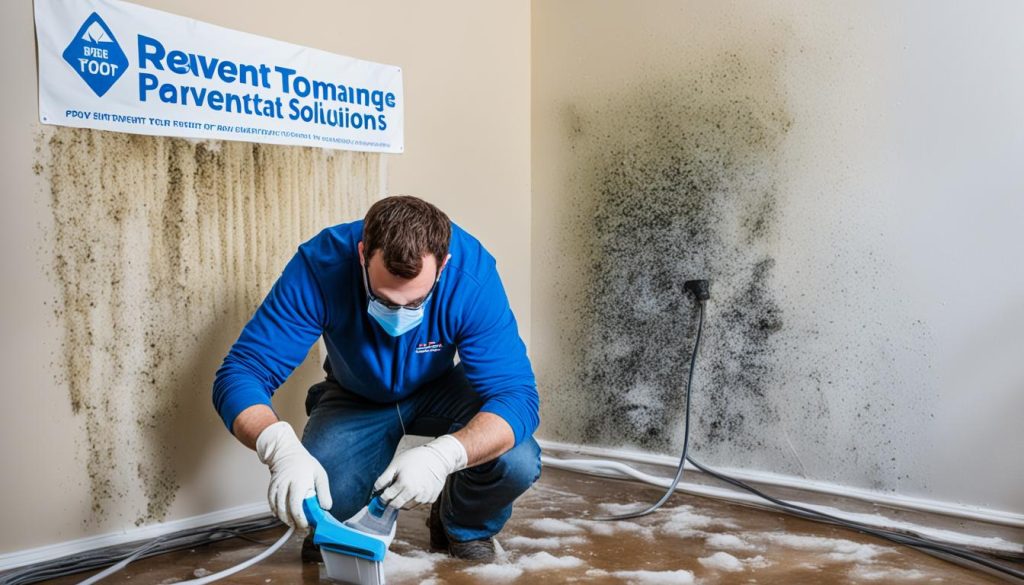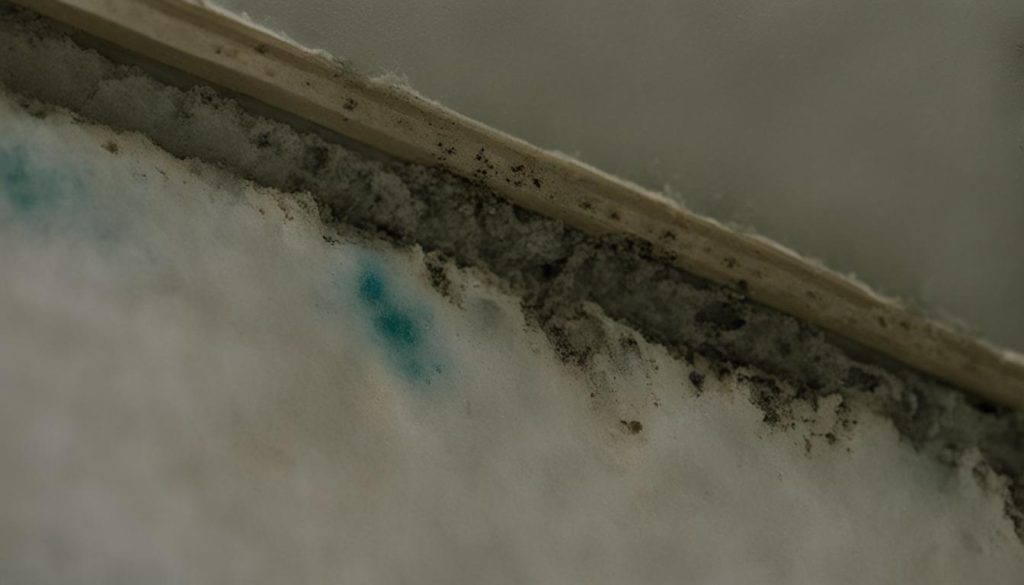Prevent Water Damage Mold – Quick Tips & Solutions
Did you know that water damage can lead to the growth of mold in your home? It’s true! In fact, according to recent studies, over 50% of homes experience mold growth after a water damage incident. Mold can pose serious health risks and cause extensive damage to your property if not addressed promptly.
Key Takeaways:
- Water damage can lead to mold growth in your home.
- Mold can cause health issues and property damage.
- Preventing mold growth is crucial after water damage.
- Removing excess moisture and drying wet areas is essential.
- Professional mold testing and remediation may be necessary.
What is Mold and How Does it Grow?
Mold is a type of fungus that flourishes in moist environments. Mold spores, which are microscopic particles, can travel through the air until they find a suitable environment with moisture to settle and grow. Common areas where mold thrives include bathrooms, windowsills, and areas with leaking roofs. Even minimal amounts of condensation can provide enough moisture for mold to grow. It’s important to note that mold allergies can cause various symptoms, including sneezing, coughing, itching, runny nose, and headaches. To maintain a healthy environment in your home, it’s crucial to prevent mold growth and its potential health effects.
The Life Cycle of Mold
Mold goes through a typical life cycle that consists of four stages: germination, growth, reproduction, and dormancy. During germination, mold spores settle in a moist environment and begin to absorb nutrients. In the growth stage, mold produces thread-like structures called hyphae, which extend and penetrate surfaces to extract additional resources. The reproduction stage involves the production of spores by mature mold colonies. Lastly, mold enters a dormant state when conditions are unfavorable, such as when moisture levels drop or temperature fluctuates.
The Effects of Mold on Health
Mold has the potential to impact human health, especially for individuals with mold allergies or sensitivities. Exposure to mold spores can trigger allergic reactions, respiratory issues, and worsen existing conditions such as asthma. Prolonged exposure to high levels of mold can result in more severe health effects. It’s essential to address mold growth promptly to prevent health complications and maintain a safe living environment.
| Health Effects of Mold | Symptoms |
|---|---|
| Allergic reactions | Sneezing, coughing, wheezing, itchy eyes/nose/throat, skin rash |
| Respiratory issues | Shortness of breath, chest tightness, congestion, sinus problems |
| Asthma exacerbation | Increase in asthma attacks, breathing difficulties |
| Systemic effects | Fatigue, headaches, dizziness, cognitive difficulties |
Steps to Prevent Mold After Water Damage
After experiencing a flood or leak, it is crucial to take immediate action to prevent the growth of mold. Mold thrives in moist environments, and addressing water damage promptly will mitigate the risk of mold infestation. Here are the essential steps to prevent mold after water damage:
1. Remove Excess Moisture
The first step is to remove any standing water or excess moisture in the affected area. This can be done by using buckets to manually remove the water or utilizing a wet-dry vacuum for larger areas. The quicker you remove the moisture, the less likely mold will have the opportunity to grow.
2. Remove Damp Carpet or Flooring
Damp carpet or flooring is highly susceptible to mold growth. To prevent mold spores from taking hold, it is essential to remove and discard any damp carpet or flooring. This will not only eliminate potential mold growth but also help with the drying process.
3. Dry Wet Floors and Furniture
Next, focus on thoroughly drying wet floors and furniture. Use towels to soak up any excess moisture and promote faster drying. Ensure proper ventilation in the area to facilitate the drying process. If necessary, consider using fans to circulate air and accelerate drying.
4. Use a Dehumidifier
Maintaining low humidity levels is key in preventing mold growth. To achieve this, utilize a dehumidifier in the affected area. A dehumidifier will extract excess moisture from the air, creating an environment that is unfavorable for mold spores to thrive.
5. Disinfect Surfaces
After removing excess moisture and drying the area, it is crucial to disinfect all surfaces to eliminate any remaining bacteria and prevent further damage. Use a consumer-grade disinfectant that is specifically formulated to kill mold and mildew.
6. Replace Damaged Items
In cases where items have been significantly damaged by water, it may be necessary to replace them entirely. This is especially true for porous materials that are difficult to fully dry and sanitize. By replacing damaged items, you eliminate potential areas for mold growth.
| Steps to Prevent Mold After Water Damage |
|---|
| Remove excess moisture |
| Remove damp carpet or flooring |
| Dry wet floors and furniture |
| Use a dehumidifier |
| Disinfect surfaces |
| Replace damaged items |
What To Do If you Find Mold After Water Damage
Mold is a common issue that can arise after experiencing water damage in your home. It’s crucial to closely monitor the affected area to identify any signs of mold growth and take immediate action. If mold is left unchecked, it can quickly spread and cause further damage to your property and pose health risks. In this section, I will address the steps you should take if you find mold after water damage and the importance of professional mold testing and evaluation.
When you discover mold in your home, it’s essential to enlist the expertise of professionals to assess the situation accurately. Professional mold testing is the most reliable and effective way to determine the presence and extent of mold growth. JSE Labs provides safe and accurate mold testing services, offering you peace of mind and expert guidance.
JSE Labs offers various options for mold testing to suit your needs. You can either drop off a mold sample for analysis or schedule an in-home visit with their experienced technicians. This comprehensive mold evaluation enables them to identify the type of mold present, assess the severity, and recommend appropriate mold remediation and removal techniques.
Once the mold has been identified and evaluated, the next step is professional mold remediation. Mold remediation involves the safe and effective removal of mold and the restoration of your home to a mold-free condition. It’s important to hire certified mold remediation specialists who have the necessary expertise, equipment, and training to handle mold removal correctly.
During the mold remediation process, it’s crucial to address the root cause of the water damage to prevent future mold growth. This may include repairing leaks, improving ventilation, or implementing moisture control measures. By addressing the underlying issues, you can reduce the likelihood of experiencing mold problems in the future.
In conclusion, if you find mold after water damage, acting promptly is essential to minimize the damage and protect your health. Professional mold testing and evaluation from trusted experts like JSE Labs can provide you with accurate information about the scope of the problem and guide you towards effective mold remediation solutions. Remember, it’s always better to address mold issues proactively rather than waiting for them to worsen.
How to Control Indoor Moisture to Prevent Mold
Controlling indoor moisture is essential in preventing mold growth in your home. Excessive moisture can create an ideal environment for mold to thrive. By implementing a few simple strategies, you can effectively manage indoor moisture levels and protect your home from mold infestation.
Bathroom Ventilation
Proper ventilation in the bathroom is crucial in reducing excess moisture. Installing a properly sized bath fan will help to remove humid air and control the humidity level. Run the fan during and after showers to vent out the moisture. Ensure that the fan is clean and functioning optimally for maximum effectiveness.
Squeegee Shower Walls
After showering, use a squeegee to remove water droplets from the shower walls. This simple step can eliminate a significant amount of moisture that would otherwise contribute to mold growth. Make it a habit to squeegee the walls after every shower to maintain a dry environment.
Paint with Mildewcide
Using paint with mildewcide in damp areas like bathrooms can provide an extra layer of protection against mold. Mildewcide is a fungicide additive that inhibits the growth of mold and mildew on painted surfaces. Choose a high-quality paint with mildewcide properties and apply it to areas prone to moisture, such as bathroom walls and ceilings.
Implementing these strategies will help you control indoor moisture levels and prevent mold growth in your home. By maintaining proper ventilation, squeegeeing shower walls, and using paint with mildewcide, you can create an environment that is inhospitable to mold.
| Preventive Measures | Benefits |
|---|---|
| Proper bathroom ventilation | – Controls humidity levels – Reduces the risk of mold growth |
| Squeegee shower walls | – Removes excess moisture – Prevents mold formation |
| Paint with mildewcide | – Provides mold-resistant surface – Inhibits mold growth |
Prevent the Top Causes of Water Damage
Water damage can be a costly and stressful problem for homeowners. However, by taking a few preventive measures, you can avoid the hassle and expense of dealing with water damage and the associated mold growth. Here are some essential steps to keep your home safe and dry.
Firstly, shutting off the main water valve when leaving your home for extended periods is a simple yet effective way to prevent unexpected leaks. By turning off the water supply, you eliminate the risk of a burst pipe or a faulty appliance causing significant water damage.
Another crucial step is to install no-burst hoses on appliances such as washing machines, faucets, and toilets. These specialized hoses are designed to withstand high water pressure and reduce the likelihood of leaks and plumbing crises. By making this small investment, you can avoid potential water damage and the need for costly repairs.
Controlling indoor humidity is also key in preventing water damage and mold growth. Proper ventilation, such as using exhaust fans in bathrooms and kitchens, can help remove excess moisture from the air. Additionally, implementing moisture-reducing strategies like using dehumidifiers and properly sealing windows and doors can keep the humidity levels in check and protect your home from potential water damage.
- Investing Wisely: How Windows & Doors in Boost Property Value and Financial Health - April 24, 2025
- The Financial Impact of Personal Injuries: Why Legal Help Matters for Business Owners - April 16, 2025
- The Hidden Financial Costs of Domestic Assault: What Business Owners Need to Know - April 16, 2025














